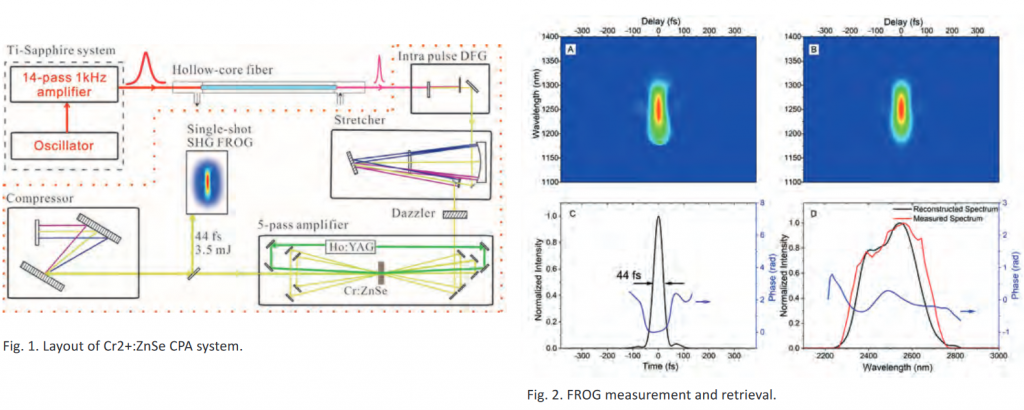The advent of femtosecond Ti:Sapphire lasers in the 1990s leads to the first demonstration for attosecond light in 2001. With commercially available lasers centered at 800 nm as the driver, extreme ultraviolet pulses with up to 150 eV photon energy can now be routinely generated for time-resolved experiments[1]. In recent years, carrier-envelope phase stabilized lasers at 1.6 to 2.1 micron based on Optical Parametric Chirped Pulse Amplification (OPCPA) pushed attosecond light sources to the “water window (282 to 533 eV)” X-rays[2]. The shortest attosecond X-ray pulses around the absorption edge of carbon atom (284 eV) was generated by driving high harmonic generation with an OPCPA based on Ti:Sapphire pumped BiBO nonlinear crystals[3]. The new generation attosecond light source allowed element and state specific attosecond transient absorption spectroscopy measurements at the nitrogen K-edge (~400 eV at for the first time[4].
A more efficient way of producing mid-infrared, high energy, femtosecond pulses is through Chirped Pulse Amplification. We have demonstrated the generation of 3.5 mJ, 44 fs, 2.5 μm laser pulses from a Chirped Pulse Amplifier employing Cr2+:ZnSe crystals as the active gain medium. The optical layout and the FROG measurements are shown in Fig. 1 and Fig. 2 respectively. Our results show the highest peak power, 80 GW, at 2.5 μm with a 1 kHz repetition rate[5, 6]. Such lasers will be powerful sources for enhancing the X-ray photon flux at/beyond the Oxygen K-edge (533 eV), which are highly desirable in chemical and material sciences.

References:
- Z. Chang, P. B. Corkum, and S. R. Leone, “Attosecond optics and technology: progress to date and future prospects [Invited],” JOSA B 33, 1081-1097 (2016).
- X. Ren, J. Li, Y. Yin, K. Zhao, A. Chew, Y. Wang, S. Hu, Y. Cheng, E. Cunningham, and Y. Wu, “Attosecond light sources in the water window,” Jour-nal of Optics 20, 023001 (2018).
- J. Li, X. Ren, Y. Yin, K. Zhao, A. Chew, Y. Cheng, E. Cunningham, Y. Wang, S. Hu, Y. Wu, M. Chini, and Z. Chang, “53-attosecond X-ray pulses reach the carbon K-edge,” Nature Communications 8, 186 (2017).
- N. Saito, H. Sannohe, N. Ishii, T. Kanai, N. Kosugi, Y. Wu, A. Chew, S. Han, Z. Chang, and J. Itatani, “Real-time observation of electronic, vibra-tional, and rotational dynamics in nitric oxide with attosecond soft X-ray pulses,” arXiv preprint arXiv:1904.10456 (2019).
- X. Ren, L. H. Mach, Y. Yin, Y. Wang, and Z. Chang, “Generation of 1 kHz, 2.3 mJ, 88 fs, 2.5 μm pulses from a Cr2+: ZnSe chirped pulse amplifier,” Optics letters 43, 3381-3384 (2018).
- Y. Wu, F. Zhou, E. W. Larsen, F. Zhuang, Y. Yin, and Z. Chang, “Generation of 3 mJ, 44 fs, 2.5 micrometer pulses from a single-stage Cr2+: ZnSe amplifier,” arXiv preprint arXiv:1910.06650 (2019).
